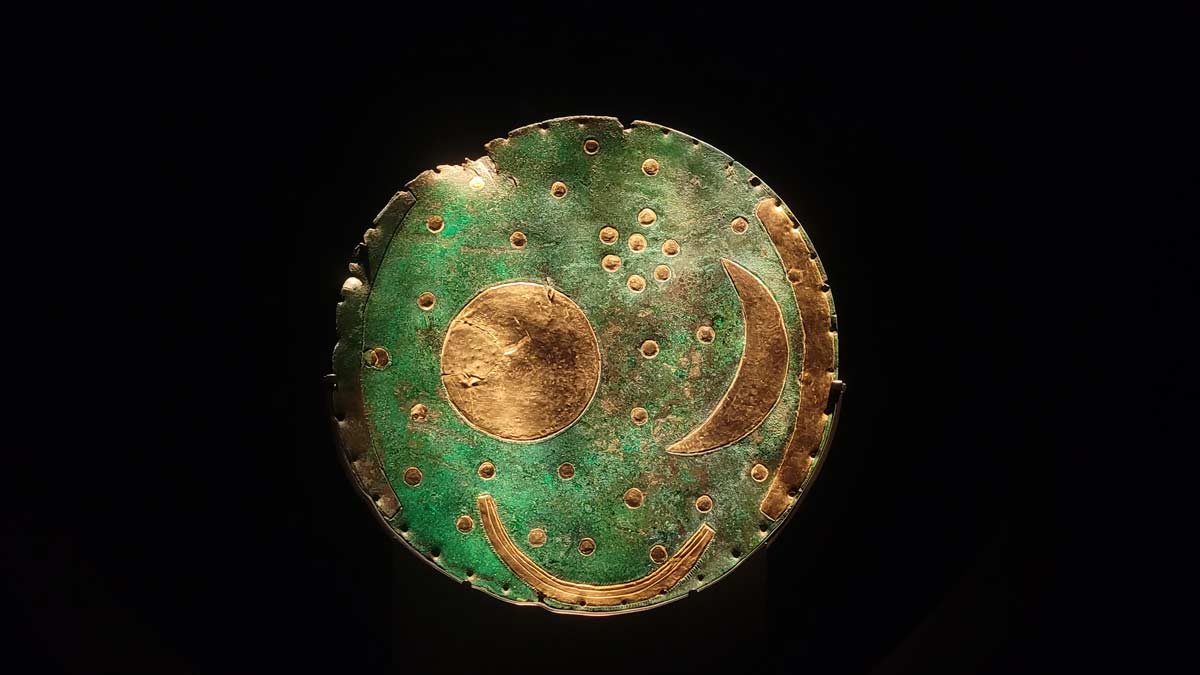Discovering Nebra Sky Disc in Germany
 The actual Nebra Sky Disc, displayed in the museum in Halle
The actual Nebra Sky Disc, displayed in the museum in Halle
A bronze disc, 32cm in diametre, shimmering with 32 stars, plus the sun or full moon, a crescent moon, and what might be a ship made in gold leaf. It could easily be a contemporary design in an art gallery, but this priceless 3,600-year-old artefact was one of the most exciting things I saw on my recent trip to Germany’s Saxony-Anhalt region. Known as the Sky Disc of Nebra, it weighs about 2.2kg but has much more historic heft. Scientists believe that the Early Bronze Age Nebra sky disc features the oldest concrete depiction of astronomical phenomena known from anywhere in the world. While it could have had religious significance, it’s clear it was used for astronomical calculations to ascertain planting and harvest times. The fact that it features the Pleiades cluster of stars and a crescent moon indicates that it may have been used to synchronise the solar and lunar calendars at the time.
I got a chance to visit Nebra, where it was found by two treasure hunters with metal detectors in 1999. Their spade hit the edge of the disc, buried almost vertically in the soil, along with two bronze swords. Nicola Scheyhing took us on a 3.5km walk through the forest in a beautiful meadow on Mittelberg Hill, which is the actual discovery site. Marked by a convex mirror reflecting the sky and a very modern building split down the middle, it’s a very quiet representation of one of the world’s most magnificent finds. One can almost picture those two turn-of-the-century adventurers who found this amazing artefact and tried to make money off it, before its significance was decoded and it came to be placed in more responsible custody.
Sadly, in its early days after resurfacing, it was dunked in a bathtub, scrubbed with steel wool, and smuggled beyond borders in an attempt to be sold in the black market, described Doris Wollenberg, who also explained the disc’s historic and scientific significance. The story and subsequent rescue of the disc in Switzerland, would lend itself to an epic action thriller, I mused. She showed us around the state-of-the-art interpretation centre dubbed The Nebra Ark. It has a fabulous interactive exhibition that tells you all you want to know about the sky disc, and even a cosy little planetarium to hold you spellbound by the science behind its creation. It was also very interesting to see how the sky disc connects with other ancient astronomical sites such as Stonehenge in the UK and the Jantar Mantar in India.
To view the disc itself, one has to visit the State Museum of Prehistory in the medieval town of Halle (on the river Saale) where you have a chance to see the real thing. Placed in a room filled with velvety darkness broken only by hundreds of tiny pinpoints of light above, the Nebra Sky Disc shines behind its glass case, beckoning hypnotically. I was completely mesmerised by its beauty, significance, and historic heft. To witness something that has been in this world for 3600+ years and that embodies the movement of the stars in the sky is to get a rare glimpse into the infinite.
Beyond the sky disc
Halle (Saale), a scenic 377-km drive northeast from Frankfurt am Main in the direction of Leipzig is a quaint town with medieval accents. Apart from the museum I mentioned above, there’s a lot to see and do while you’re there.
History and architecture: The most imposing structure in the centre of what used to be the town’s salt market is the ‘market church’ or Marktkirche Unser Lieben Frauen, a late Gothic church built between 1529 and 1554 AD. I was fortunate to be at the right place at the right time to witness trumpeters performing at 40 metres above ground, on the bridge high up between the Watchmen’s Towers! My excellent guide Hans Joachim Kress tells me Marktkirche even saw Martin Luther delivering his controversial sermons in 1545 AD and composer Johann Sebastian Bach advising on the new organ in 1713 AD and playing it at its inauguration three years later!
Music: Not far away, is Handel House, the birthplace of Baroque musical composer George Frideric Handel, now a beautiful museum dedicated to his life that I enjoy exploring. Halle is filled with landmarks from his life from when he was born in 1685 AD until he turned 18 – where he was baptised, and where his teacher Friedrich Zachau taught him to play the organ (a small one above the altar in the same Marktkirche, it’s one of the oldest in Central Germany and can still be seen today). If classical music is not your thing, you could check out the amazing The Beatles’ Museum there, which they claim to be ‘the world’s oldest, largest and most extensive public institution dedicated to The Beatles’. With their songs playing, unique memorabilia and products, letters and photographs, life-size mannequins, a music studio, and even a gigantic Abbey Road jigsaw puzzle that you can help with, this is an immersive experience of the life and times of the band before 1970 and their individual career trajectories thereafter.
Food and drink: After a pleasing stroll through the scenic town, I enjoyed a traditional German dinner of pork schnitzel with housemade ‘dunkel’ or dark beer at the Gasthaus Zum Schad on Kleine Klausstrasse. There are many options in Halle, despite it being a small town. Vegetarians will find a good proportion of restaurants catering to their dietary preferences, including several Indian ones. And if you’d like to be a little more adventurous, head to the cutting-edge vegan restaurant June, which offers delicious vegan fare in a set menu of shared plates, each more sophisticated than the last.
Tourism